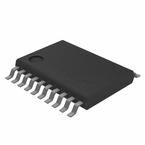DESCRIPTION
●The Texas Instruments MSP430™ family of ultra-low-power microcontrollers consist of several devices featuring different sets of peripherals targeted for various applications. The architecture, combined with five low-power modes is optimized to achieve extended battery life in portable measurement applications. The device features a powerful 16-bit RISC CPU, 16-bit registers, and constant generators that contribute to maximum code efficiency. The digitally controlled oscillator (DCO) allows wake-up from low-power modes to active mode in less than 1 µs.
●FEATURES
●• Low Supply Voltage Range: 1.8 V to 3.6 V
●• Ultra-Low Power Consumption
●– Active Mode: 220 µA at 1 MHz, 2.2 V
●– Standby Mode: 0.5 µA
●– Off Mode (RAM Retention): 0.1 µA
●• Five Power-Saving Modes
●• Ultra-Fast Wake-Up From Standby Mode in Less Than 1 µs
●• 16-Bit RISC Architecture, 62.5-ns Instruction Cycle Time
●• Basic Clock Module Configurations
●– Internal Frequencies up to 16 MHz With Four Calibrated Frequencies
●– Internal Very-Low-Power Low-Frequency (LF) Oscillator
●– 32-kHz Crystal
●– External Digital Clock Source
●• One 16-Bit Timer_A With Three Capture/Compare Registers
●• Up to 16 Touch-Sense Enabled I/O Pins
●• Universal Serial Interface (USI) Supporting SPI and I2C
●• 10-Bit 200-ksps Analog-to-Digital (A/D) Converter With Internal Reference, Sample-and-Hold, and Autoscan (MSP430G2x32 Only)
●• Brownout Detector
●• Serial Onboard Programming, No External Programming Voltage Needed, Programmable Code Protection by Security Fuse
●• On-Chip Emulation Logic With Spy-Bi-Wire Interface
●• Family Members are Summarized in Table 1
●• Package Options
●– TSSOP: 14 Pin, 20 Pin
●– PDIP: 20 Pin
●– QFN: 16 Pin
●• For Complete Module Descriptions, See the MSP430x2xx Family User’ s Guide (SLAU144)


